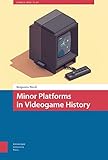Minor Platforms in Videogame History / Benjamin Nicoll.
Material type: TextSeries: Games and Play ; 2Publisher: Amsterdam : Amsterdam University Press, [2019]Copyright date: ©2019Description: 1 online resource (212 p.)Content type:
TextSeries: Games and Play ; 2Publisher: Amsterdam : Amsterdam University Press, [2019]Copyright date: ©2019Description: 1 online resource (212 p.)Content type: - 9789048540303
- online - DeGruyter
| Item type | Current library | Call number | URL | Status | Notes | Barcode | |
|---|---|---|---|---|---|---|---|
 eBook
eBook
|
Biblioteca "Angelicum" Pont. Univ. S.Tommaso d'Aquino Nuvola online | online - DeGruyter (Browse shelf(Opens below)) | Online access | Not for loan (Accesso limitato) | Accesso per gli utenti autorizzati / Access for authorized users | (dgr)9789048540303 |
Frontmatter -- Table of Contents -- List of Tables and Figures -- Acknowledgements -- Introduction : Failed, forgotten, or overlooked? Methods for historicizing minor platforms -- 1. Ways of seeing videogame history: The Vectrex as a transitional platform -- 2. Articulations of videogame piracy: The Zemmix as a decolonial platform -- 3. Domesticating the arcade: The Neo Geo as an imaginary platform -- 4. A dialectic of obsolescence? The Sega Saturn as a residual platform -- 5. 'How history arrives': Twine as a minor platform -- Conclusion: 'Something new in the old' -- Index
restricted access online access with authorization star
http://purl.org/coar/access_right/c_16ec
Videogame history is not just a history of one successful technology replacing the next. It is also a history of platforms and communities that never quite made it; that struggled to make their voices heard; that aggravated against the conventions of the day; and that never enjoyed the commercial success or recognition of their major counterparts. In Minor Platforms in Videogame History, Benjamin Nicoll argues that 'minor' game histories are anything but insignificant. Through an analysis of transitional, decolonial, imaginary, residual, and minor videogame platforms, Nicoll seeks out moments of difference and discontinuity in game history. From the domestication of vector graphics in the early years of videogame consoles to the proliferation of videogame piracy in South Korea in the 1980s, this book explores case studies that challenge taken-for-granted approaches to videogames, platforms, and their histories.
Mode of access: Internet via World Wide Web.
In English.
Description based on online resource; title from PDF title page (publisher's Web site, viewed 02. Mrz 2022)


